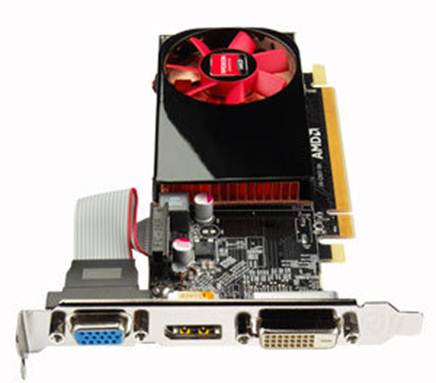Get 3D for free
There are two main ways in which you can
view stereoscopic images on a screen that contains no special 3D hardware.
These methods can be used with specially prepared photos, movies and websites.
We’ll also explain how you can generate
your own 3D content to view this way. You might consider the first method old
hat, but it’s so simple and a lot more effective than you might expect.
The stereo image shown above left is called
an anaglyph, and it’s the type that’s viewed using those cardboard glasses with
the red and blue lenses. The first anaglyphs were monochrome, but colour was
added later. Colour accuracy is sacrificed, but the end result can be pretty
impressive.

If
your processor doesn’t have the necessary capabilities, you’ll need to invest
in a 3D-Capable Graphics Card
An anaglyph superimposes the left and right
images on top of each other, with one printed in shades or red and the other in
cyan. Because the red lens in the glasses passes the red image but stops the
cyan image, and vice versa, each eye sees only the correct image. And because,
between them, the two lenses allow the three primary colours of red, green and
blue to pass, a full colour image is achievable.
Some DVD movies are available in anaglyph
3D versions, and there’s no shortage of anaglyph photo galleries and movie
clips online. Even Google Maps has anaglyph support just click on the image and
press T in Street View. Glasses for anaglyph viewing are widely available for
pennies, if you buy them in bulk, otherwise you’ll pay a pound or so for a
single pair.
Make sure you get the red-cyan glasses as
opposed to the various alternative anaglyph glasses, such as the red-green type
that are suitable only for red-green monochrome anaglyphs.
The second free method is even more
surprising, since you need nothing at all – not even a pair of cardboard specs.
The two images are displayed side by side onscreen, the left image on the left
and the right one on the right. All you have to do is persuade your eyes to see
a 3D result.
It does take several attempts to get the
hang of this, and the size of the image is limited. However, as your skill
improves in the necessary visual gymnastics, you’ll be able to see larger
images in 3D.
To perform this feat, view the onscreen
image at a comfortable viewing distance and allow your eyes to go cross-eyed,
merging the left and right images. You’ll find you’re now seeing three blurred
images: the left image, the combined images, and the right image. Try to relax your
eyes so the centre image drops into focus, but without losing that
all-important overlap. When you achieve this the centre image will appear in
3D.
In the main you’ll be using this method
with content you’ve created yourself, but a Google search will reveal no
shortage of galleries of side-by-side 3D images.
Upgrade your PC for ‘real’ 3D
You’ll need a suitable graphics chip to
display real 3D on your PC. There are three main manufacturers: Intel, nVidia
and AMD. As long as your PC is relatively new, it should already have the
necessary tech.
If your Pc has an Intel processor, look for
integrated HD graphics 2000 or later. Most Sandy- and Ivy Bridge Core i3, i5 or
i7 processor have built-in graphics chips, but not all, AMD’s A-Series APUs
also support 3D.

If
you have a 3D-Ready TV, you may be able to experience true 3D from your PC at
no additional cost
If your PC doesn’t have a 3D-capable
graphics chip already, you’ll need to install a new graphics card. The nVidia
GeForce GTX 600 series is a good place to start as the cards don’t cost a
fortune.
If you’d rather plump for an AMD based
graphics card, the Radeon HD 6450 or later will do the trick. Given that you
can pick one up for just $37.5, it’s a low-cost route into 3D if your CPU
doesn’t have the necessary capability.
The other piece of the 3D puzzle is the
monitor. If you’re in the market for a 3D upgrade, you might prefer to first
choose your monitor and then turn your attention to the graphics card. This is
because the monitor will probably be your most expensive purchase, and your
selected model may support only a specific 3D standard. Those with support for
nVidia’s 3D Vision require an nVidia graphics card, for example.
Due to the huge number of possible hardware
combinations, we can’t provide a definitive list of which monitors will work
with which graphics card. It’s vitally important that you check before you buy
that your selected products will work together.
Many monitors are bundle with the necessary
3D glasses. You can buy an entry-level passive monitor for as little as $232.5
with the 23in LG D2342P-PN. If you’d prefer to use an active-shutter version,
prices start at around $390 with the 24in Acer Aspire 3D GD245HQA, which is
bundled with 3D Vision glasses and has a built-in wireless transmitter.
Naturally, you can spend much more on a 3D monitor.
None of this hardware is any use without
the necessary software, of course, so you’ll need to invest in some suitable
applications. If your prime interest is in watching 3D movies, the latest version
of the big-name movie-playing software will all be able to handle 3D Blu-ray;
some will also upscale 2D films and photos to 3D. such upscale content won’t be
nearly as impressive as genuine 3D movies or photos, of course.
Some examples include CyberLink PowerDVD
12.0, Roxio CinePlayer BD with 3D and ArcSoft Total Media Theatre.

PowerDVD
12 is the ultimate universal media player that extends your viewing experience
beyond just movies on PCs
For gamers, the list of native 3D games is
constantly growing, and converting games from 2D to 3D on the fly by
interpreting the DirectX stream is also possible. Watch out for compatibility
issues, as some support only nVidia 3D Vision and might require the TriDef 2D
to 3D convertion middleware to work with Intel or AMD hardware.